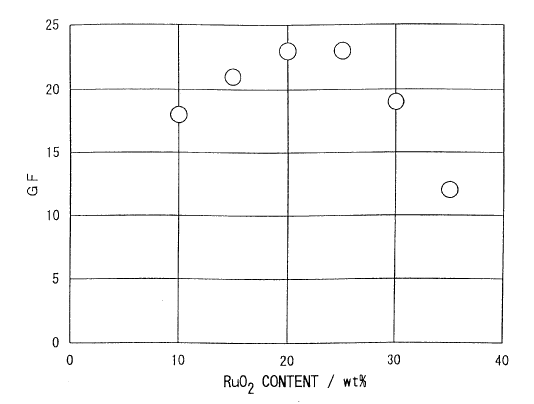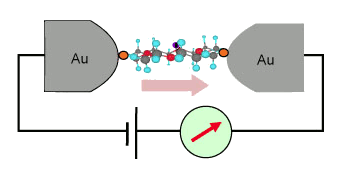Piezomolecular Effect
February 22, 2011
Carbon has many useful properties beyond just burning it for heat. One reason for this is that it exists in several solid forms, known as
allotropes.
Diamond is a good
abrasive,
graphite makes great
"lead" pencils, and
fullerenes helped to launch
nanotechnology. Graphite is a
semiconductor, and it was very useful in early electronics as the material in
resistors. It also has the useful property (in some cases) that its
electrical conductivity increases quite a bit as
temperature increases. This is a semiconductor property, and it's useful for making a primitive
thermometer, like the
liquid nitrogen level detectors I used to make to monitor our
dewars in the lab.
Resistors, of course, are everywhere, but the next important use of carbon in electronics was as a
microphone material.
Thomas Edison discovered that sound pressure can change the resistance of carbon particles placed between conducting plates. Edison patented this device, later called a
carbon button microphone, in March, 1877, and it found its way into
transmitters and
telephones.
The mechanism for action, which was something quite understandable in Edison's day, was that the pressure acting on the loose particles causes more contacts through which
current could flow. The fact that carbon is a semiconductor was superfluous, except that it made the particles conducting. A variation in the carbon button microphone effect can be found in
composite materials, typically polymers loaded with conducting particles, that change resistance with applied
stress. Sometimes the materials are a bit more exotic, as when
ruthenium oxide particles are mixed into
glass to form a
piezoresistive material with excellent properties (see figure).[1]

Fig. 3 of US patent no. 5,985,183 showing piezoresistive gauge factor as a function of ruthenium oxide content.[1]
A somewhat similar mechanical affect on conductance was found much earlier, in 1856, by
William Thomson (Lord Kelvin), of the
eponymous temperature scale. Kelvin found the
piezoresistive effect, a change in resistance of metals with applied stress caused merely by a change in their shape. For a bar-shaped conductor, the resistance increases with length and decreases with cross-sectional area, and this was the effect that Kelvin saw.
Piezoresistance is much different for semiconductor crystals, as discovered by Charles S. Smith of
Bell Labs in 1954.[2] The piezoresistive effect he saw was much greater than a geometry change could explain. As Smith conjectured, "This so called electron transfer effect arises in the structure of the
energy bands of these semiconductors..." The situation is that the stress causes a redistribution of
charge carriers of different
mobilities.
Nowadays, "nano" is the name of the game, so it's no wonder that piezoresistance has been reduced to its smallest possible dimension. An international team from
Arizona State University (Tempe, Arizona), the
University of Barcelona (Barcelona, Spain),
Fudan University (Shanghai, China) and the
Max-Planck-Institute for Polymer Research (Mainz, Germany), led by
Nongjian Tao of Arizona State University, has demonstrated the piezoresistance of a single molecule of
pentaphenylene.[3-4]
I've termed this the "piezomolecular" effect, but you won't find anything piezomolecular if you search
Google. It's a word that I invented, a
neologism. Yes, what this research team found is piezoresistance, but I don't think the word, piezoresistive, adequately captures what they've done. We could call it the "
LCAO piezoresistive effect," which is descriptive, but I don't think it would have popular appeal.
I'm not ashamed of my presumption, since
physicists invent words all the time. There is, of course, the example of
Gell-Mann's quarks. A recent example is
David Mermin, who named the geometric pattern on the surface of one of the
phases of
superfluid 3He a "
boojum."[5] Mermin lifted the term from
Lewis Carroll's "
The Hunting of the Snark," just like Gell-Mann found quark in
Finnegans Wake by
James Joyce. My term is much less creative.

The figure above shows the concept of the piezomolecular experiment, but the simplicity of the figure belies the difficulty of the experiment. Details of how the researchers were able to put molecules between
electrodes can be found in the
supplementary information (1.4 Mb PDF file) to their paper. The research group was able to vary the molecule's conductance over an order of magnitude. In the experiment, the molecule was stretched by varying the height of one electrode with respect to the other.
As could be expected, maximum conductance was obtained at minimum stretch when the
p-orbitals of the
carbon backbone had more of an overlap. As a control, the team used
tetraphenyl molecules, which would not have this overlapping of p-orbitals, and there was no conductance change. Other tests were performed to ensure that they were not seeing any affects from the electrode contacts.
If you shoot a beam of light through the molecules captured between electrodes, I'm sure you'll see some changes to the light as the molecules stretch; perhaps in both
polarization and intensity, but surely in the
absorption spectrum. The signal may be too weak if the beam goes through just one molecule, but it might work with a stack of a few hundred. Now, there's a challenge!
References:
- Yoshihiro Hori, Haruhiko Handa, Shinya Hasegawa and Masaki Ikeda, "Piezoresistance paste and mechanical sensor using the same," US Patent No. 5,985,183 (November 16, 1999).
- C. S. Smith, "Piezoresistance Effect in Germanium and Silicon," Phys. Rev., vol. 94, no. 1 (April, 1954), pp. 42-49, 1954.
- Ismael Diez-Perez, Joshua Hihath, Thomas Hines, Zhong-Sheng Wang, Gang Zhou, Klaus Müllen and Nongjian Tao, "Controlling single-molecule conductance through lateral coupling of π orbitals," Nature Nanotechnology (Published online, 20 February 2011)
- Richard Harth, "Manipulating Molecules for a New Breed of Electronics," Arizona State University Press Release, February 20, 2011.
- N. David Mermin, "E Pluribus Boojum: the physicist as neologist," Physics Today, vol. 34, no. 4 (April 1981), pp. 46-53.
Permanent Link to this article
Linked Keywords: Carbon; allotrope; Diamond; abrasive; graphite; pencils; fullerene; nanotechnology; semiconductor; resistor; electrical conductivity; temperature; thermometer; liquid nitrogen; dewar; microphone; Thomas Edison; carbon button microphone; transmitter; telephone; current; composite material; stress; ruthenium oxide; glass; piezoresistive material; US patent no. 5,985,183; gauge factor; William Thomson; Lord Kelvin; piezoresistive effect; Bell Labs; energy bands; charge carrier; mobility; Arizona State University (Tempe, Arizona); University of Barcelona (Barcelona, Spain); Fudan University (Shanghai, China); Max-Planck-Institute for Polymer Research (Mainz, Germany); Nongjian Tao; pentaphenylene; Google; neologism; LCAO; physicist; Murray Gell-Mann; quark; David Mermin; phase; superfluid; 3He; Lewis Carroll; The Hunting of the Snark; Finnegans Wake; James Joyce; electrode; p-orbital; carbon backbone; tetraphenyl; polarization; absorption spectrum.